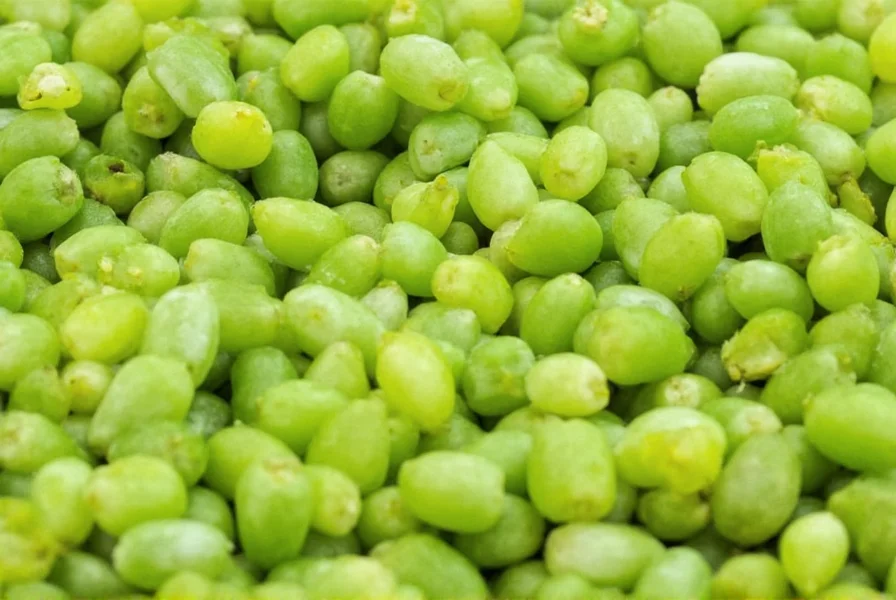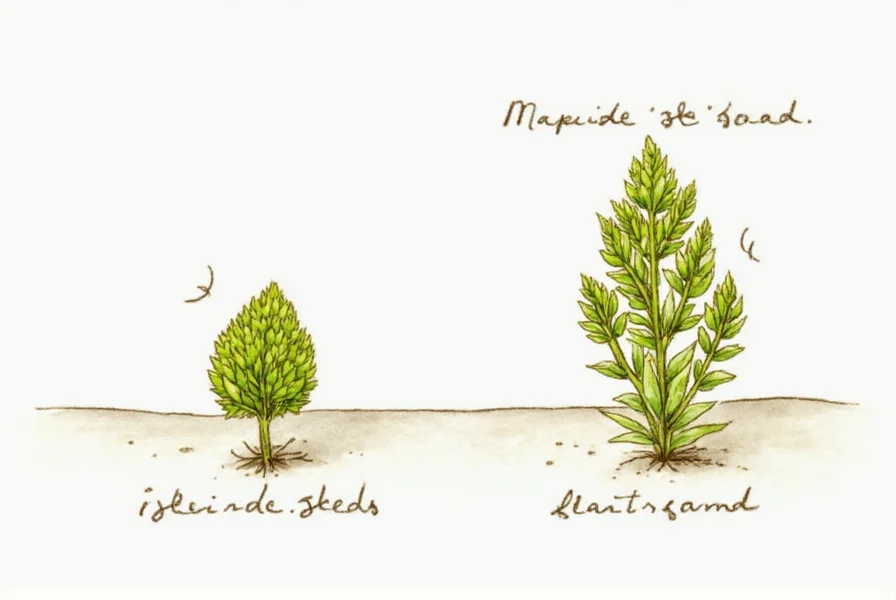Mustard plants have fascinated gardeners and botanists for centuries due to their remarkable growth potential from such tiny seeds. Despite measuring only 1-2 millimeters in diameter, these minuscule seeds contain all the genetic information needed to develop into robust plants that can tower over other garden vegetables. The transformation from seed to mature plant follows a predictable biological process that gardeners can optimize with proper care.
The Three Main Mustard Plant Varieties
When exploring what does a mustard seed grow into, it's essential to understand the three primary species that produce what we commonly call "mustard seeds":
| Variety | Scientific Name | Seed Characteristics | Mature Plant Height |
|---|---|---|---|
| Black Mustard | Brassica nigra | Smallest, darkest seeds | 6-8 feet |
| Brown Indian Mustard | Brassica juncea | Moderate size, brown seeds | 4-6 feet |
| White/Yellow Mustard | Sinapis alba | Largest, pale yellow seeds | 3-5 feet |
Each variety follows a similar growth pattern but with slight differences in maturation time and environmental preferences. Black mustard tends to grow tallest but is less cold-tolerant than the other varieties. Brown Indian mustard offers the most versatility, with edible leaves, stems, and seeds. White mustard grows most quickly and is often used as a cover crop.
Mustard Seed Growth Stages Explained
Understanding how long does it take for a mustard seed to grow requires examining its complete life cycle. The transformation happens through several distinct phases:
Germination (Days 1-7)
When planted in moist soil at temperatures between 45-85°F (7-29°C), mustard seeds typically germinate within 3-10 days. The seed coat splits open as the radicle (embryonic root) emerges downward while the hypocotyl (stem) pushes upward toward the light. This initial growth stage requires consistent moisture but not waterlogged conditions.
Seedling Development (Weeks 2-4)
Within two weeks, the first true leaves appear above the cotyledons (seed leaves). These initial leaves have a distinctive mustard flavor even at this early stage. The root system establishes itself more deeply during this period, with the taproot growing downward while lateral roots spread horizontally. Proper thinning at this stage ensures adequate space for each plant to reach its full potential.
Vegatative Growth (Weeks 5-8)
During this rapid growth phase, mustard plants develop their characteristic lobed leaves. The stem thickens and gains height quickly—sometimes adding several inches per day under ideal conditions. Gardeners harvesting mustard greens typically pick leaves during this stage, which provides continuous harvest while encouraging bushier growth. The plant focuses energy on leaf production before transitioning to flowering.
Flowering and Seed Production (Weeks 9-12)
As days lengthen or temperatures warm, mustard plants enter their reproductive phase. Bright yellow flowers appear in clusters, eventually developing into seed pods. Each pod contains multiple seeds that start green and immature, then gradually turn brown as they mature. This is the stage when understanding what plant does a mustard seed produce becomes visually apparent—the very seeds being harvested came from identical plants in previous seasons.

Optimal Growing Conditions for Mustard Plants
For gardeners wondering can you grow mustard from seed successfully, attention to these environmental factors proves crucial:
- Soil Requirements: Mustard thrives in well-draining loamy soil with a pH between 6.0-7.5. While adaptable to various soil types, it performs best with moderate fertility.
- Sunlight Needs: Full sun (6+ hours daily) produces the most robust growth, though partial shade extends the harvest period for leaf production.
- Watering Schedule: Consistent moisture is essential, particularly during germination and seedling stages. Established plants tolerate some drought but produce better with regular watering.
- Temperature Range: Cool to moderate temperatures (50-75°F or 10-24°C) optimize growth. Mustard bolts (goes to seed) quickly in hot weather, which affects leaf quality.
Understanding mustard seed growth stages helps gardeners time their planting appropriately. In temperate climates, spring and fall plantings yield the best results, while gardeners in warmer regions often plant in late fall for winter harvest.
Practical Applications of Mustard Plants
Knowing what does a mature mustard plant look like reveals its multiple uses beyond just seed production:
Mustard greens represent one of the most nutritious leafy vegetables, packed with vitamins A, C, and K. The young leaves offer a mild flavor perfect for salads, while mature leaves develop the characteristic pungent taste preferred in cooked dishes. The flowers are edible too, adding a peppery note to salads.
Gardeners interested in sustainable practices appreciate mustard's role as a cover crop. Its rapid growth suppresses weeds, and when tilled into soil, it releases compounds that help reduce soil-borne pathogens—a process called biofumigation. This makes understanding the mustard plant life cycle valuable for organic farmers.
For culinary enthusiasts exploring how to grow mustard seeds for beginners, patience is required. Seeds must remain on the plant until fully mature and dry before harvesting. The pods will turn brown and become brittle when ready for collection. After harvesting, the seeds need thorough drying before storage to prevent mold.
Common Misconceptions About Mustard Growth
Several myths persist about what does a mustard seed grow into, often stemming from the famous biblical parable that compares the kingdom of heaven to a mustard seed. While poetic, this reference doesn't provide accurate botanical information.
Contrary to some beliefs, mustard plants don't grow into trees. They're herbaceous annuals that complete their life cycle in one growing season. The parable likely referred to the relative size difference between the tiny seed and the relatively large plant it produces compared to other garden plants of that era.
Another common question concerns how tall does a mustard plant grow. While exceptionally vigorous specimens of black mustard might approach 8 feet under perfect conditions, most garden varieties reach 3-6 feet. The plant's height depends significantly on variety, soil quality, water availability, and climate conditions.
Harvesting and Preserving Mustard Seeds
For those growing mustard specifically for seed production, timing the harvest correctly proves essential. Watch for the lower pods to turn brown while upper pods remain green. This indicates the plant has reached peak seed maturity. Cut the entire plant and hang it upside down in a dry, well-ventilated area to finish drying.
Once completely dry, thresh the seeds by rubbing the pods between your hands over a clean surface. Winnow away the chaff by pouring the mixture between containers in a gentle breeze. Properly dried seeds should feel hard and make a clicking sound when shaken.
Store mustard seeds in airtight containers away from light and heat. Under proper conditions, they maintain viability for planting for 4-5 years and retain culinary quality for 2-3 years. For gardeners interested in seed saving, this completes the cycle of what does a mustard seed grow into and how to continue the process.
How long does it take for a mustard seed to grow into a mature plant?
Most mustard varieties reach maturity in 80-95 days from planting. Some fast-growing types like white mustard can produce harvestable leaves in as little as 20 days, while seed production typically requires 3-4 months depending on variety and growing conditions.
Can you eat the leaves of the mustard plant that grows from mustard seeds?
Yes, the leaves of all mustard plants are edible and commonly known as mustard greens. Young leaves have a mild, peppery flavor perfect for salads, while mature leaves develop a stronger, more pungent taste ideal for cooking. Mustard greens are highly nutritious, containing significant amounts of vitamins A, C, and K.
What's the difference between mustard seeds from different colored mustard plants?
Black mustard seeds (Brassica nigra) are smallest and most pungent, commonly used in Indian cuisine. Brown mustard seeds (Brassica juncea) are medium-sized with a strong heat, often used in Chinese and Russian mustards. Yellow mustard seeds (Sinapis alba) are largest and mildest, typically used in American-style yellow mustard. Each variety produces distinctly flavored condiments.
Do mustard plants come back every year?
No, mustard plants are annuals that complete their entire life cycle in one growing season. They don't come back year after year like perennials. However, if seeds are left to mature and drop naturally, they may self-seed and appear in subsequent seasons, creating the appearance of a perennial plant.
How much space does a mustard plant need to grow properly?
For optimal growth, space mustard plants 6-12 inches apart in rows 18-24 inches apart. Closer spacing works for leaf production (as in mustard greens), while wider spacing allows plants to develop larger seed heads. Overcrowding leads to smaller plants and reduced seed production due to competition for light, water, and nutrients.











 浙公网安备
33010002000092号
浙公网安备
33010002000092号 浙B2-20120091-4
浙B2-20120091-4